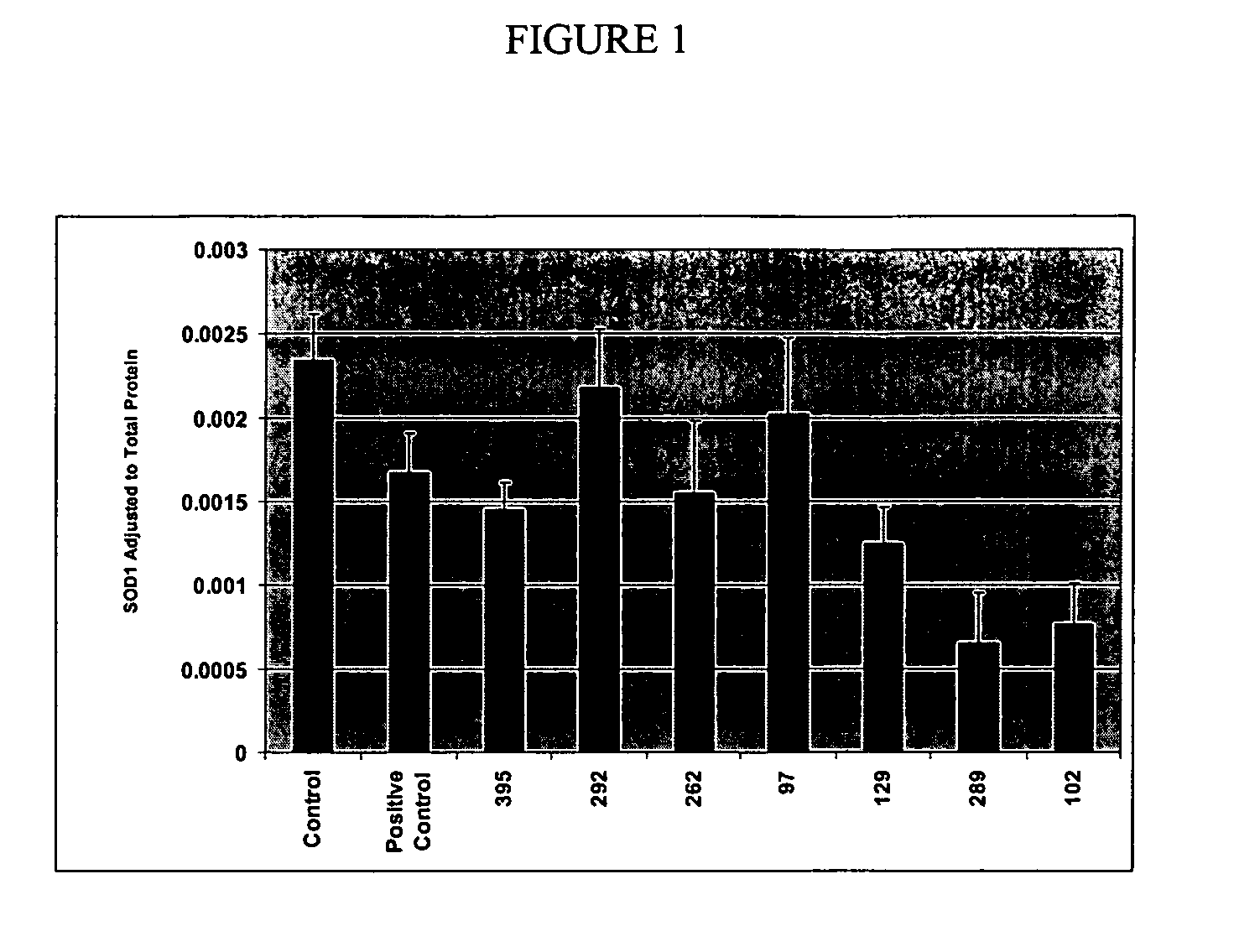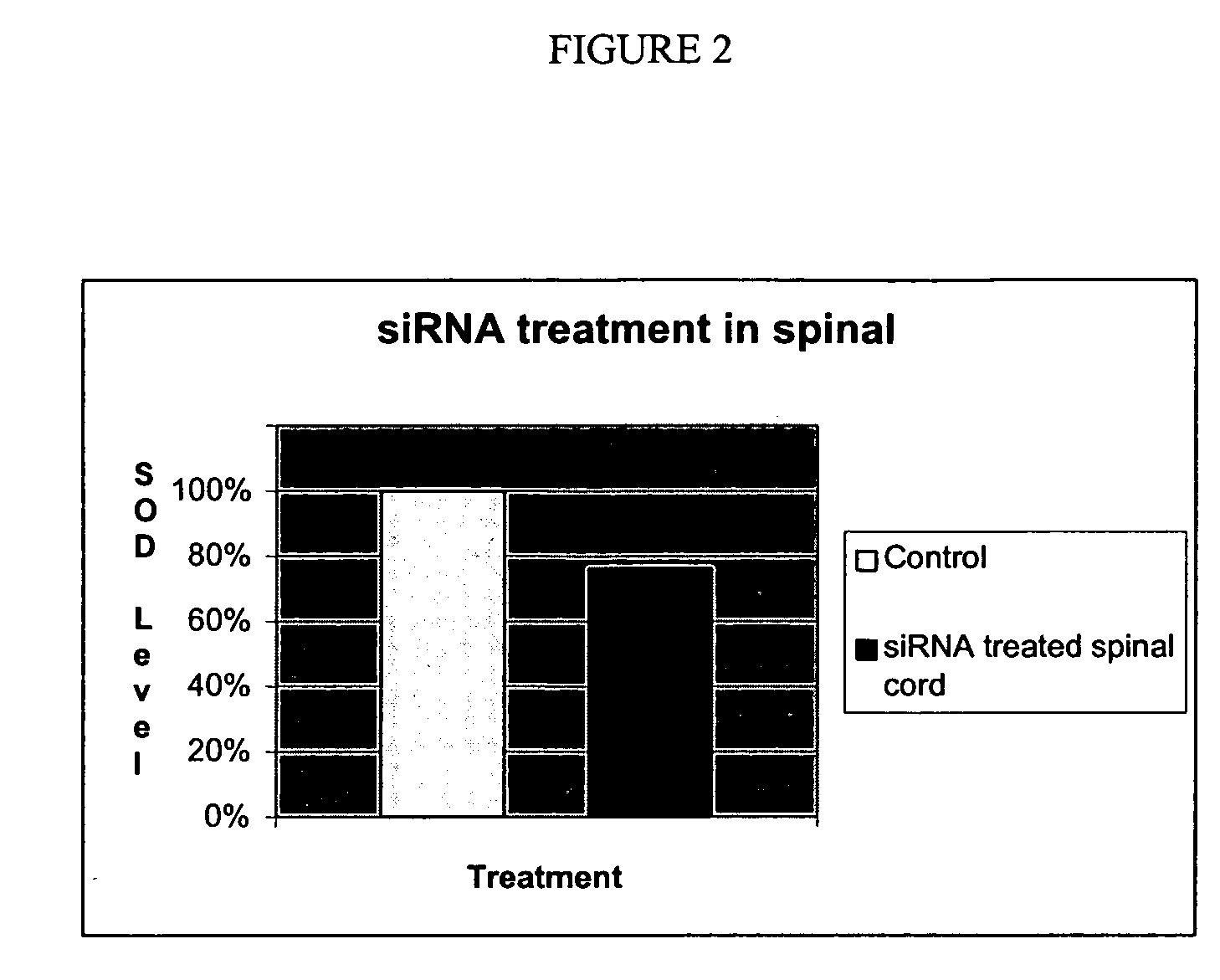Small interference RNA (siRNA) molecules for modulating superoxide dismutase (SOD)
a superoxide dismutase and small interference technology, applied in the direction of genetic material ingredients, drug compositions, enzymology, etc., can solve the problems of limiting the use of this technology and rna interference, and achieve the effects of facilitating the selection of sirna sequences, improving the access to the cytosolic site of action, and reducing the number of sirna sequences
- Summary
- Abstract
- Description
- Claims
- Application Information
AI Technical Summary
Benefits of technology
Problems solved by technology
Method used
Image
Examples
example 1
Designing siRNA
[0080] Targets for siRNA were designed for wild type SOD-1 mRNA. A general strategy for designing siRNA targets comprises beginning at the start codon for exon 3 of SOD-1 and then scanning the length of exon 3. The potential target site can then be compared to the appropriate genome database, so that any target sequences that have significant homology to non-target genes can be discarded. Multiple target sequences along the length of the gene should be located, so that target sequences are derived from the 3′, 5′ and medial portions of the mRNA of exon 3. Negative control siRNAs can be generated using the same nucleotide composition as the subject siRNA, but scrambled and checked so as to lack sequence homology to any genes of the cells being transfected (Elbashir et al. (2001) Nature, 411, 494-498; Ambion siRNA Design Protocol, at www.ambion.com).
[0081] In the present invention, generated target sequences were 19 bases long, beginning with start codon of exon 3 (SE...
example 2
Testing siRNA In Vitro
[0083] To quantify the effect the inhibition of expression in vitro, attenuation of gene function was assessed by the measurement of mRNA using typical real time fluorescence detection technologies, and by the measurement of immunoreactivity using an enzyme linked immunosorbent assay (ELISA; Bender Medsystems MST222).
[0084] Briefly, HeLa cells (ATCC) were plated into 96 well microtiter plates at a density of 4000 cells / well and allowed 12 hours to attach. Following an initial 12 hour incubation, annealed duplex RNA was added to each well at concentrations from 20 nM through 10 uM, in the presence and absence of lipid transfection reagents. Cultures were assayed following 24-72 h of RNA treatment. Control sequences with the same base composition but different orders of nucleotides were tested in parallel fashion.
[0085] The data showed that siRNA targeted to SOD-1 could decrease SOD-1 expression. Cultured hippocampal neurons were treated with various concentra...
example 3
Testing siRNA In Vivo: siRNA Knockdown of Mouse SOD1 mRNA
[0088] To quantify the effect the inhibition of expression in vitro, the siRNA molecules was introduced into the SOD-93A murine model (GTC Biotherapeutics, Inc., Framingham, Mass.) for ALS, and the life expectancy measured. The inhibition of RNA expression was monitored by isolated blood samples from a mouse pre- and post introduction of the siRNA molecule using standard RT-PCR techniques. The expression of the SOD-1 protein was determined using ELISA, Western blot techniques, or TaqMan quantitative PCR.
[0089] In vivo experiments were conducted with siRNA molecules that show a significant reduction (i.e., greater than 10%, preferably greater than 20%, most preferably greater than 50%) of SOD1 levels. siRNA molecules that were showed a 50% reduction in vitro at a concentration of about 50 nM siRNA were tested in vivo. This concentration is low enough that therapeutically relevant drug levels should be achievable in the spinal...
PUM
| Property | Measurement | Unit |
|---|---|---|
| length | aaaaa | aaaaa |
| outer diameter | aaaaa | aaaaa |
| diameter | aaaaa | aaaaa |
Abstract
Description
Claims
Application Information
 Login to View More
Login to View More - R&D
- Intellectual Property
- Life Sciences
- Materials
- Tech Scout
- Unparalleled Data Quality
- Higher Quality Content
- 60% Fewer Hallucinations
Browse by: Latest US Patents, China's latest patents, Technical Efficacy Thesaurus, Application Domain, Technology Topic, Popular Technical Reports.
© 2025 PatSnap. All rights reserved.Legal|Privacy policy|Modern Slavery Act Transparency Statement|Sitemap|About US| Contact US: help@patsnap.com


